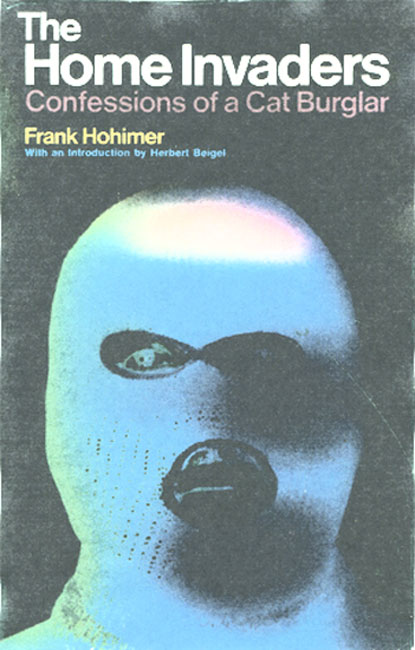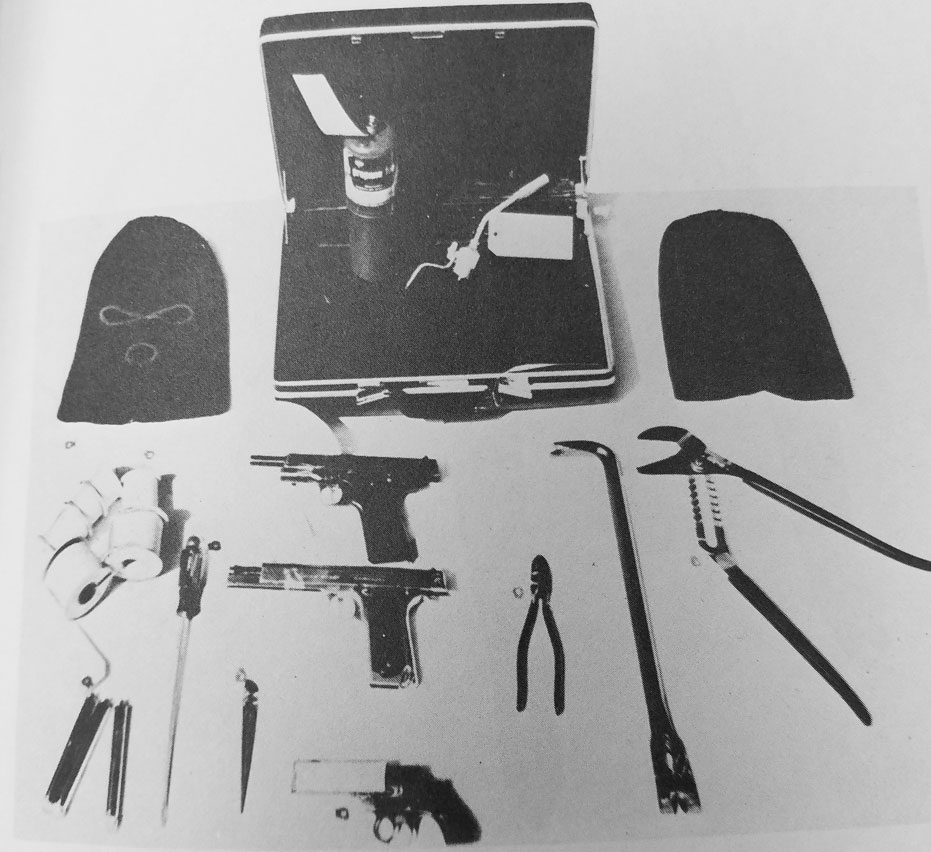Thank you to user Any of N for the information that inspired this post!
“Don’t be alarmed if someone shines a light on your face around two or three in the morning, dressed completely in black and wearing a ski mask and gloves … Don’t wonder how he got in … no lock or alarm is going to keep you secure … No sense in reaching for the phone, the wires have been cut.”
No, that is not a quote from the East Area Rapist. It’s from a book that may or may not have inspired him.
When it comes to offenders who begin their crime sprees seemingly fully-formed, much like the East Area Rapist did, one of the main questions we have to ask is “Where did they learn to do this?”
Is this simply the continuation of a previous crime spree with a new M.O.? Did they have a mentor? Did they read a “how-to” book?
Don’t laugh at that last one. Proboard user “Any of N” came up with an interesting find. A book called “The Home Invaders” by Frank Hohimer looked like it just might be that book.

The problem was that it was rare, and no one was able to locate a copy. Then someone came through for me and spent a pretty penny purchasing one. It arrived the other day, and when I started reading it, my jaw dropped. The book was many things… partly about a criminal career, partly about the criminal justice system of the 1960s and early 1970s, and partly a HOW-TO book.
Early in his life, Frank Hohimer (a.k.a. “John Seybold” according to several sources) spent eleven years in a prison, where instead of being rehabilitated, he learned to be a better criminal. He was tutored by Okla Smith, a man who might’ve been the greatest cat burglar in the world, on how to commit crimes and evade detection. (Side note: Smith was in prison for killing his wife. He’d never been arrested for burglary). And Smith himself had learned the “trade” from other mentors. Hohimer was benefitting from the experience of generations of thieves.
Upon Hohimer’s release, he immediately began a “successful” career as a cat burglar. He would’ve continued undetected had he not become mixed up in the Mafia. He ended up on the FBI’s “Most Wanted” list for two years, and eventually turned himself in. At the time of his arrest, he was wanted in Denver, Indianapolis, Connecticut, and Illinois.
Before going to jail, he had been making three to five million per year as a cat burglar (he was working only the most exclusive and wealthy neighborhoods). After some interesting deals with the federal prosecutors (the corruption of the FBI is emphasized during these portions), he ended up going to prison at Fort Madison, Iowa, serving a thirty-year term. It was in this prison cell that he wrote the book.
“The Home Invaders” is unique in the sense that there were no professional writers involved, only an editor to fix punctuation and grammar issues. It reads very conversationally. He describes his “craft,” his rules, his preparation, and his activities. In fact, preparation is emphasized quite a bit. His skills were described by Time Magazine in the following way: ““Worked with military precision… known for stealth and daring.”
He mentioned that his hits weren’t “guesswork,” and that he always had precise information. He didn’t worry about the police because the way that he worked, it was impossible to get caught. And after reading about his methods, I can see why the thought that. Some of the “rules” that he was taught included:
- “Always keep your face and hands covered on a burglary.”
- “Don’t bother checking the children, they will sleep through anything, noise will hardly wake them up.”
- “Check the refrigerator. If there is a small baby in the house, there will be formula in there.”
- “Open every door on the ground floor, so you have plenty of exits, then lock them back just like you found them before you leave.”
- “Before you work a neighborhood, make damn sure that you know how the cops and security patrol work.”
- “Never drive a car in the neighborhood you’re hitting. The first thing cops look for is a car driving out. Or a nosy neighbor may jot down the number. Park your car miles away so you get back to it just when people are starting to drive to work. If you’re driving at 2 or 3 in the morning, you might throw a stop from a nosy copper. You can fall in with morning traffic and drive right out of the city.”
- “Never use slip on sneakers, use the tie kind. Slip ons fall off. When you get back to the car, change clothes as soon and as fast as possible.”
- “If you have to run, there’s no way to catch you over back fences and through yards.”
- “Never leave tracks crossing a wet or dewy black top. Lay down and roll if you have to and the cops won’t know you’ve crossed.”
- “Do not have any strong scent like deodorant or shaving lotion. It might wake people up.”
- “The more people are in the house, the safer you are. They’ll think it’s someone else if they hear someone moving around.”
- “Never be afraid of dogs, they can sense fear. Most dogs are friendly, snap your fingers and they come to you. Call them lightly right out of the house, roll them a ball, throw a stick, they will go get it.”
- “Don’t cast a shadow across a window.”
- “Never offend where you live.”
Does this… um… sound like anyone else I’ve written about?

The mass-market version was published in January 1975, and one has to wonder if a young East Area Rapist got his hands on a copy somehow. The title would have certainly appealed to him. The methods, the dress, the flashlight, even the time of night certainly rings true.
Of course, the Hohimer book isn’t the only place he could’ve learned these things, and even if he did learn them here, there’s not much we can do with that from an investigative standpoint. But this could be an interesting piece of the puzzle, a little glimpse of what might’ve helped form such a criminal who was looking to start out.
There are a few major differences between Hohimer and the East Area Rapist, of course, especially when it comes to violence. Hohimer writes “Professional burglars never kill no matter what. It creates too much unnecessary heat. He never HAS to kill. He takes the whole house over in a matter of minutes … I have been in hundreds of homes, but I’ve never harmed anyone. Why? I was a professional. I always had immediate control of the situation. I worked silent as a cat and I never woke any member of any household making an entry.”
His first night out as a criminal had some interesting parallels to the East Area Rapist’s own first documented attack in June 1976. Hohimer emphasized picking out certain houses first, a group of them, then narrowing down the target. And patience. Waiting for people to retire at around 10 or 11, then starting to move around the yards at 1:00 AM. The rest of his first night went like this:
He hopped a few back fences across a few yards. He went to the back door of his target and started chipping away at the door frame, and then pushed the knife against the lock to successfully open it. Then he waited half an hour to make sure he hadn’t alerted anyone to his presence. He roamed the house without waking the sleeping couple and stole their jewelry. After the burglary, he went to the refridgerator and drank a quart of milk. He hit another house, and then a final one. On his last hit of the night, he decided to wake the couple up. He put on his ski mask, then shined the light in their faces and told them he wanted their money, just like he’d been taught. He bound them with neck ties, robbed them, ran back to his car to change, and disappeared into morning traffic at around 5:45 AM.
Creepy. The rest of the book talks about his various experiences, and like I mentioned earlier, talks a lot about how corrupt Law Enforcement was at the time. Surprisingly, Herbert Beigel, a member of the federal task force assigned to Hohimer’s case, talks more about the corruption than Hohimer does. Beigel calls the FBI a “government spy ring” and not a law enforcement agency, and the book discusses how bribes were given to local police by Hohimer for them to ignore him while he was in their town. Fascinating stuff, but not all agencies were like that.
I found the information in the book unnerving, and I can easily see someone looking to embark on a life of crime finding it useful. Whether or not EAR ever came across it, I don’t know. But some of the elements are there.